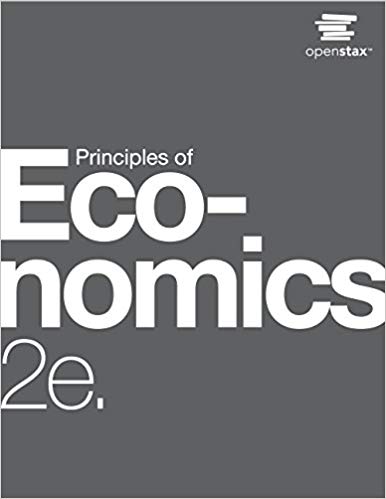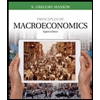
Principles of Economics 2e
2nd Edition
ISBN: 9781947172364
Author: Steven A. Greenlaw; David Shapiro
Publisher: OpenStax
expand_more
expand_more
format_list_bulleted
Textbook Question
Chapter 33, Problem 4SCQ
In Germany it takes three workers to make one television and four workers to make one video camera. In Poland It takes six workers to make one television and 12 workers to make one video camera.
- Who has the
absolute advantage in the production of televisions? Who has the absolute advantage in the production of video cameras? How can you tell? - Calculate the
opportunity cost of producing one additional television set in Germany and In Poland. (Your calculation may involve fractions, which Is tine.) Which country has acomparative advantage in the production of televisions? - Calculate the opportunity cost of producing one video camera in Germany and in Poland. Which country has a comparative advantage in the production of video cameras?
- In this example, is absolute advantage the same as comparative advantage, or not?
- In what product should Germany specialize? In what product should Poland specialize?
Expert Solution & Answer
Trending nowThis is a popular solution!

Chapter 33 Solutions
Principles of Economics 2e
Ch. 33 - True or False: The source of comparative advantage...Ch. 33 - Brazil can produce 100 pounds of beef or 10 autos....Ch. 33 - In France it takes one worker to produce one...Ch. 33 - In Germany it takes three workers to make one...Ch. 33 - How can there be any economic gains for a country...Ch. 33 - Table 33.15 shows how the average costs of...Ch. 33 - If the removal of trade banters is so beneficial...Ch. 33 - What is absolute advantage? What is comparative...Ch. 33 - Under what conditions does comparative advantage...Ch. 33 - What factors does Paul Krugman identity that...
Ch. 33 - Is it possible to have a comparative advantage in...Ch. 33 - How does comparative advantage lead to gains from...Ch. 33 - What is intra-industry trade?Ch. 33 - What are the two main sources of economic gains...Ch. 33 - What is splitting up the value chain?Ch. 33 - Are the gains from international trade more likely...Ch. 33 - Are differences in geography behind the...Ch. 33 - Why does the United States not have an absolute...Ch. 33 - Look at Exercise 33.2. Compute the opportunity...Ch. 33 - You just overheard your friend say the following:...Ch. 33 - Look at Table 33.9. Is there a range of trades for...Ch. 33 - You just got a job in Washington, D.C. You move...Ch. 33 - Does intra-industry trade contradict the theory of...Ch. 33 - Do consumers benefit from intra-industry trade?Ch. 33 - Why might intra-industry trade seem surprising...Ch. 33 - In World Trade Organization meetings, what do you...Ch. 33 - Why might a low-income country put up barriers to...Ch. 33 - Can a nations comparative advantage change over...Ch. 33 - France and Tunisia both have Mediterranean...Ch. 33 - In Japan, one worker can make 5 tons of rubber or...Ch. 33 - Review the numbers for Canada and Venezuela from...Ch. 33 - In Exercise 33.31, is there an ask where...Ch. 33 - From earlier chapters you will recall that...Ch. 33 - Consider two countries: South Korea and Taiwan....Ch. 33 - If trade increases world GDP by 1 per year, what...
Additional Business Textbook Solutions
Find more solutions based on key concepts
E2-13 Identifying increases and decreases in accounts and normal balances
Learning Objective 2
Insert the mis...
Horngren's Accounting (11th Edition)
Prepare an adjusted trial balance from the following account information, and also considering the adjustment d...
Principles of Accounting Volume 1
Discussion Questions 1. What characteristics of the product or manufacturing process would lead a company to us...
Managerial Accounting (4th Edition)
Discuss the major advantages and disadvantages of small businesses.
Principles of Management
Ravenna Candles recently purchased candleholders for resale in its shops. Which of the following costs would be...
Financial Accounting (12th Edition) (What's New in Accounting)
Define cost pool, cost tracing, cost allocation, and cost-allocation base.
Horngren's Cost Accounting: A Managerial Emphasis (16th Edition)
Knowledge Booster
Similar questions
- In Japan, one worker can make 5 tons of rubber or 80 radios. In Malaysia, one worker can make 10 tons of rubber or 40 radios. Who has the absolute advantage in the production of rubber or radios? How can you tell? Calculate the opportunity cost of producing 80 additional radios in Japan and in Malaysia. (Your calculation may involve fractions, which is fine,) Which country has a comparative advantage in the production of radios? Calculate the opportunity cost of producing 10 additional tons of rubber in Japan and in Malaysia. Which country has a comparative advantage in producing rubber? In this example, does each country have an absolute advantage and a comparative advantage in the same good? In what product should Japan specialize? In what product should Malaysia specialize?arrow_forwardBrazil can produce 100 pounds of beef or 10 autos. In contrast the United States can produce 40 pounds of beef or 30 autos. Which country has the absolute advantage in beef? Which country has the absolute advantage in producing autos? What is the opportunity cost of producing one pound of beef In Brazil? What is the opportunity cost of producing one pound of beef in the United States?arrow_forward
Recommended textbooks for you
 Principles of Economics 2eEconomicsISBN:9781947172364Author:Steven A. Greenlaw; David ShapiroPublisher:OpenStax
Principles of Economics 2eEconomicsISBN:9781947172364Author:Steven A. Greenlaw; David ShapiroPublisher:OpenStax Brief Principles of Macroeconomics (MindTap Cours...EconomicsISBN:9781337091985Author:N. Gregory MankiwPublisher:Cengage Learning
Brief Principles of Macroeconomics (MindTap Cours...EconomicsISBN:9781337091985Author:N. Gregory MankiwPublisher:Cengage Learning Principles of Macroeconomics (MindTap Course List)EconomicsISBN:9781305971509Author:N. Gregory MankiwPublisher:Cengage Learning
Principles of Macroeconomics (MindTap Course List)EconomicsISBN:9781305971509Author:N. Gregory MankiwPublisher:Cengage Learning Principles of Economics, 7th Edition (MindTap Cou...EconomicsISBN:9781285165875Author:N. Gregory MankiwPublisher:Cengage Learning
Principles of Economics, 7th Edition (MindTap Cou...EconomicsISBN:9781285165875Author:N. Gregory MankiwPublisher:Cengage Learning Principles of Economics (MindTap Course List)EconomicsISBN:9781305585126Author:N. Gregory MankiwPublisher:Cengage Learning
Principles of Economics (MindTap Course List)EconomicsISBN:9781305585126Author:N. Gregory MankiwPublisher:Cengage Learning Principles of Macroeconomics (MindTap Course List)EconomicsISBN:9781285165912Author:N. Gregory MankiwPublisher:Cengage Learning
Principles of Macroeconomics (MindTap Course List)EconomicsISBN:9781285165912Author:N. Gregory MankiwPublisher:Cengage Learning

Principles of Economics 2e
Economics
ISBN:9781947172364
Author:Steven A. Greenlaw; David Shapiro
Publisher:OpenStax

Brief Principles of Macroeconomics (MindTap Cours...
Economics
ISBN:9781337091985
Author:N. Gregory Mankiw
Publisher:Cengage Learning

Principles of Macroeconomics (MindTap Course List)
Economics
ISBN:9781305971509
Author:N. Gregory Mankiw
Publisher:Cengage Learning

Principles of Economics, 7th Edition (MindTap Cou...
Economics
ISBN:9781285165875
Author:N. Gregory Mankiw
Publisher:Cengage Learning

Principles of Economics (MindTap Course List)
Economics
ISBN:9781305585126
Author:N. Gregory Mankiw
Publisher:Cengage Learning

Principles of Macroeconomics (MindTap Course List)
Economics
ISBN:9781285165912
Author:N. Gregory Mankiw
Publisher:Cengage Learning